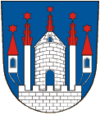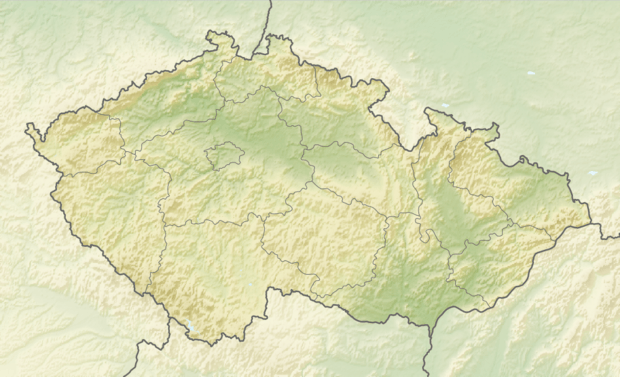Zábřeh
Zábřeh (Czech pronunciation: [ˈzaːbr̝ɛx]; German: Hohenstadt) is a town in the Šumperk District, in the Olomouc Region of the Czech Republic. From 1938 to 1945 it was one of the municipalities in Sudetenland.
Zábřeh Hohenstadt | |
|---|---|
Town | |
 Castle in Zábřeh | |
 Flag  Coat of arms | |
 Zábřeh Location in the Czech Republic | |
| Coordinates: 49°52′55″N 16°52′29″E | |
| Country | |
| Region | Olomouc |
| District | Šumperk |
| First mentioned | 1254 |
| Government | |
| • Mayor | František John (KDU-ČSL) |
| Area | |
| • Total | 34.58 km2 (13.35 sq mi) |
| Elevation | 285 m (935 ft) |
| Population (2019-01-01)[1] | |
| • Total | 13,589 |
| • Density | 390/km2 (1,000/sq mi) |
| Time zone | UTC+1 (CET) |
| • Summer (DST) | UTC+2 (CEST) |
| Postal code | 789 01 |
| Website | https://www.zabreh.cz/ |
Etymology
The name “Zábřeh” consists of two parts. The prefix “zá”, meaning “behind”, and the noun “břeh” meaning “riverbank”. It is a reference to the nearby Moravská Sázava river. The town's railway station is named "Zábřeh na Moravě“ (literally Zábřeh in Moravia) to distinguish it from another station called Zábřeh, now part of Dolní Benešov in Silesia, therefore the town is sometimes called “Zábřeh na Moravě”, however its official name is just Zábřeh”.
“Hohenstadt” is the German name. This name consists of the adjective “hohen” (“high”) and the noun “stadt” (“town”). A name with the same meaning is used in Latin sources – “Alta Civitas”. The origin of this name is unclear, as the town is situated in lowlands.

Geography
About half of the town is situated in the lowlands of the Mohelnická brázda depression and the second half is located on the hillside of Zábřežská vrchovina (literally “Zábřeh Highlands”)
The Moravská Sázava river flows through the south of the town, and an international railway corridor runs along this river.
The town is a part of the Hanakia ethnographic region.
The Zábřeh Town Council also administers four nearby villages – Dolní Bušínov, Hněvkov, Pivonín and Václavov.
Demography
The population of the town is around 13,500.
Zábřeh was originally a Czech town with a German minority and a Jewish community. Most Jews were killed during the Nazi occupation, and the Germans were expelled in 1945 after Germany's borders were redrawn by the victorious Allied powers. Abandoned houses were taken over by Czechs from different parts of the country.
Nowadays, the town is populated by a Czech majority and significant Romani and Vietnamese minorities.
History of population
- 1880 – 6017 people in 785 houses
- 1900 – 7166 people in 829 houses
- 1930 – 9122 people in 1294 houses
- 1950 – 8449 people in 1627 houses
- 1970 – 11 420 people in 1607 houses
- 1991 – 15 005 people in 1948 houses
- 2001 – 14 561 people in 2006 houses[2]
Economy
The unemployment rate was 12.7% in 2011.
Historically Zábřeh was a textile town profiting from its location next to the international railway. Textile companies bankrupted in the 1990s due to former communist administration and cheap Asian competition. Therefore, the west part of the town is occupied by brownfield land which hasn’t been revitalized yet and is sporadically used as warehouses, workshops and as recreation space.
Zábřeh is situated in fertile lowland which is used for agricultural production. Maize, wheat, oilseed rape, poppy and fodder plant are grown. A tall silo is situated in outskirt of the town and helps create town panorama.
In the south of the town, next to the railway, a dairy is located. The Olma[3] dairy produces yoghurts, milk, cream, butter and cheese. Its products are known in Czech Republic as well in Slovakia, Poland and Hungary. The owner is Andrej Babiš.
The Sulko[4] factory produces plastic windows and doors. Part of the production is exported to west Europe.
The HDO factory processes zinc alloy.
The Pass company, connected with automotive training school, provides complex truck and cars repair services.
The butchery of Jiří Rýznar and The Hevos, the kitchen producer and designer, are regionally significant.
U.S.-based Belmont Trading Company[5] operates an eMaterials processing and recycling facility which prepares used mobile devices, computing equipment, and telecom network equipment for resale or recycling.
History
Zábřeh has a long and rich past. The first note about the town dates back to 1254, when a man by the name of Sulislav from Zábřeh was mentioned. It is known that the city itself was founded before 1289, because of the name Hohenstadt appearing in sources. This was most likely a fortress around which a plantation began to grow, transforming into a town gradually.
The ownership of Zábřeh can be ascribed to many famous houses of the time. The most famous one and probably the most cruel one was the house of Tunkl. Their ownership of the town dates back to 1442. The house was known for its countless arguments with neighbouring masters and also for its behaviour towards its vassals. However, they rebuilt the fortress and changed it into a castle, they had also a merit in pond foundation around the river Moravská Sázava. The struggle of vassals against their master Jiří Sr. Tunkl between 1492 and 1494 marked the end of this house. Then the town came under the mastership of the house Trčkové from Lípa, but only for a little while. The house was replaced by a more powerful one – the Boskovicové.
The town went through a lot during further years. The situation improved in the 18th century, when the castle was rebuilt once again and extended along with a baroque parish church. In the 19th century the Prague - Olomouc railway was built through the town marking Zábřeh as a powerful centre of economy, government and cultural life.
Until 1918, Hohenstadt - Zábřeh (German name only before 1867) was part of the Austrian monarchy (Austria side after the compromise of 1867), head of the district with the same name, one of the 34 Bezirkshauptmannschaften in Moravia.[6] The city was connected to the railway before 1850.[7]
In 1938, it was occupied by the Nazi Army as one of the municipalities in Sudetenland. The German speaking population was expelled in 1945 (see the Beneš decrees).
Notable people
- Ondřej Bank, Czech alpine skier
- František Kahlik (1854–1908) - a teacher, a historian and a geographer, Kahlik founded the first Czech grammar-school in north-west Moravia in the year 1896. His son Václav Kálik was a known composer.
- Ctirad Kohoutek, Czech composer
- Luboš Kohoutek, Czech astronomer
- Josef Macek (1887–1972) - a politician and an economist, Macek was connected with the University of business in Prague and lately with the university of Pittsburgh.
- Jaroslav Mostecký, Czech writer
- Emil Novák, Czech snowboarder
- Magdalena Vizovská – born in one of the town's oldest house Dům pod podloubím located on Masaryk's square Vizovská is best known as a wife of famous Jan Amos Komenský.
- Robin Wagner, Czech cyclist
- Jan Eskymo Welzl (1868–1948) - a traveller, a polar explorer, a gold-digger and most importantly an adventurer.
References
- "Population of municipalities of the Czech republic". Czech Statistical Office. Retrieved 2019-04-30.
- http://vdb.czso.cz/vdbvo/tabdetail.jsp?kapitola_id=5&pro_1_154=541354&cislotab=MOS+ZV01%5B%5D
- "Welcome to OLMA, a.s."
- s.r.o., SULKO. "SULKO – Spolehlivá okna již více než 20 let".
- http://www.belmont-trading.com
- Die postalischen Abstempelungen auf den österreichischen Postwertzeichen-Ausgaben 1867, 1883 und 1890, Wilhelm Klein, 1967
- Handbook of Austria and Lombardy-Venetia Cancellations on the Postage Stamp Issues 1850-1864, by Edwin Mueller, 1961, Eisenb. Hohenstadt
- "Strategie rozvoje města Zábřeh 2015–2020". zabreh.cz (in Czech). Město Zábřeh. p. 42. Retrieved 2019-09-07.
Biography
- Melzer, Miloš, Schulz, Jindřich a kol. Vlastivěda šumperského okresu. Šumperk : Okresní vlastivědné muzeum Šumperk, 1993. 585 s. ISBN 80-85083-02-7.
![]()